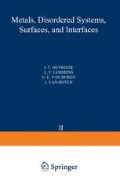Abstract
The effective interatomic potentials of the transition metals are reported which are calculated within the framework of the pseudopotential approximation based on a model potential of the Heine Abarenkov type. The results obtained are combined with the cluster variation method in order to make predictions on the phase diagram of the ternary system CuNiZn. The predictions on the phase diagram are in reasonable agreement with experiments taking into account more-body forces and are topologically correct.
Access this chapter
Tax calculation will be finalised at checkout
Purchases are for personal use only
Preview
Unable to display preview. Download preview PDF.
References
R. Kikuchi, Physical Review, 81, 988 (1951).
W.A. Harrison, Pseudopotentials in the Theory of Metals, (Benjamin, Reading) 1966, p.5.
V. Heine, D. Weaire, Solid State Physics (Academic Press, London) 1970, p.249.
V. Heine, I. Abarenkov, Philosophical Magasine, 9 ,451 (1964).
F.S. Ham, Solid State Physics, Academic Press, New York, 1 127 (1955).
A.O.E. Animalu, Physical Review, B8, 3542 (1973).
M.J. Huyben, W. van der Lugt, W.A.M. Reimert, J.Th.M. de Hosson, C. van Dijk, Physics 97 B+C, 338 (1978) and references.
H. Thomas, Zeitschrift für Metallkunde, 63, 106 (1963).
W. Köster, R. Störing, Zeitschrift für Metallkunde, 51, 182 (1972).
A. Kuzsmann, H. Wollenberger, Zeitschrift für Metallkunde, 50, 94 (1959).
J.Th.M. de Hosson, American Institute of Physics, 53 146 (1979).
G.J.L. van der Wegen, P.M. Bronsveld, J.Th.M. de Hosson, Scripta Metallurgica, 13, 303 (1979).
J. de Groot, P.M. Bronsveld, J.Th.M. de Hosson, Physica Status Solidi (a), 52, 635 (1979).
Author information
Authors and Affiliations
Editor information
Editors and Affiliations
Rights and permissions
Copyright information
© 1981 Plenum Press, New York
About this chapter
Cite this chapter
de Rooy, A., van Royen, E.W., de Hosson, J.T.W. (1981). Pseudopotentials and Alloying Behaviour. In: Devreese, J.T., Lemmens, L.F., Van Doren, V.E., Van Royen, J. (eds) Recent Developments in Condensed Matter Physics. Springer, Boston, MA. https://doi.org/10.1007/978-1-4684-3899-4_7
Download citation
DOI: https://doi.org/10.1007/978-1-4684-3899-4_7
Publisher Name: Springer, Boston, MA
Print ISBN: 978-1-4684-3901-4
Online ISBN: 978-1-4684-3899-4
eBook Packages: Springer Book Archive

